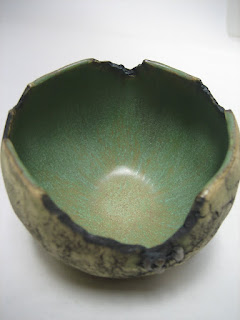Yesterday, my friend and fellow studio artist, Tyrell Collins, came down the hall to see my newest glazed work, just out of the kiln. As she ooohed and ahhhed over the work she said, “You know, these are great examples of Wabi Sabi – where you’ve juxtapositioned the smooth, finish glazed insides with the cracked, uneven outsides."




And then she mentioned a book which was given to her by our fellow studio artist, Kunio, who is Japanese - “Wabi Sabi: for Artists, Designers, Poets and Philosophers” by Leonard Koren. I just might have to get this publication and have a looksee.
I had no idea what she was talking about. I’d never heard of Wabi Sabi, although many years ago, I spent a good two months traveling and studying pottery in Japan. But I do know that all my time as a working and teaching artist, this idea of the beauty of the imperfect, impermanent, and incomplete has been an unconscious, aesthetic quest.
And how many times did I tried to instill in my students, especially the inmates to whom I taught pottery in various California prisons over the years, the idea that what makes a particular piece beautiful is not that it’s perfect, but that you can see the hand of the artist in it?
My favorite saying when they would bemoan the fact that their thrown cup wasn’t exactly round, or perfectly even: “You want perfect? Buy it at K-Mart,” I’d say. It made me smile when, years later, I would walk into the class and hear one of the “old timers” of the class say to a “newbie”, “You want perfect? Get it at K-Mart.”
So now, in my 44th year of playing in the mud, I find there is a whole philosophy, a whole comprehensive Japanese world view centered on the acceptance of transcience and imperfection, just where my aesthetics fit in.
Wabi Sabi.
Who knew?

